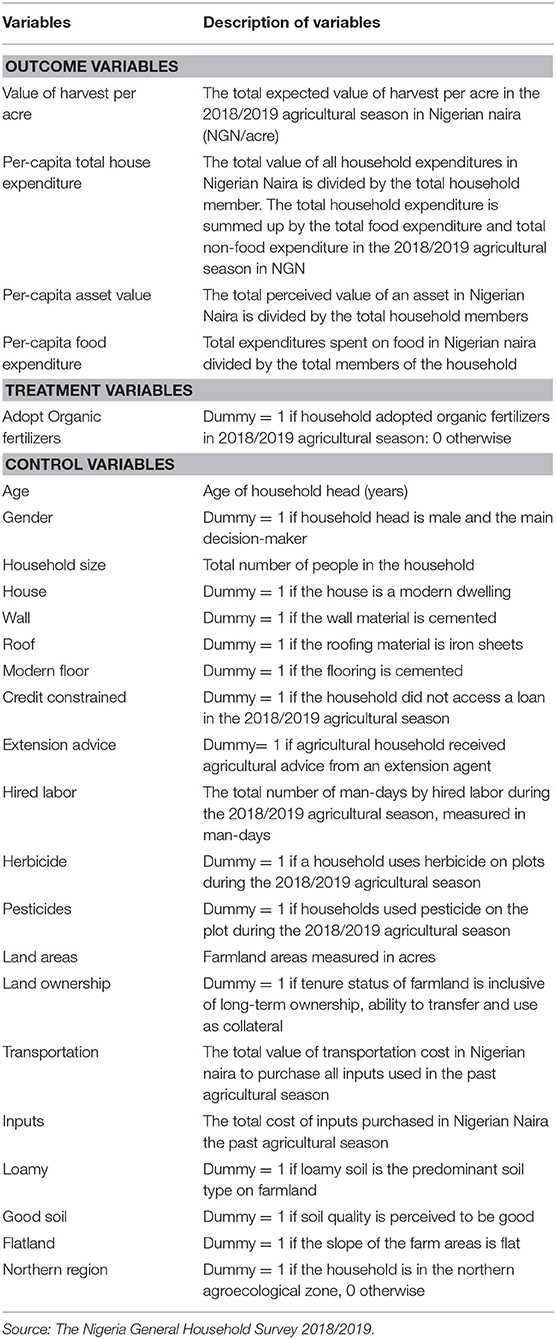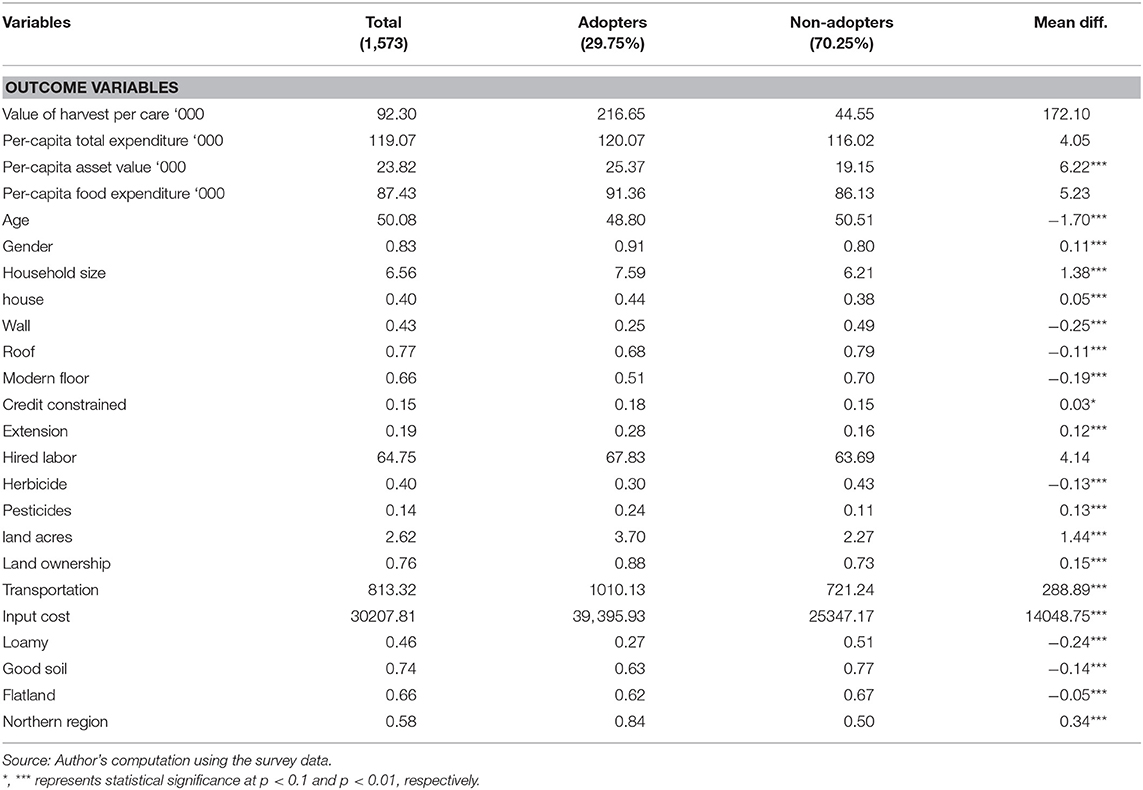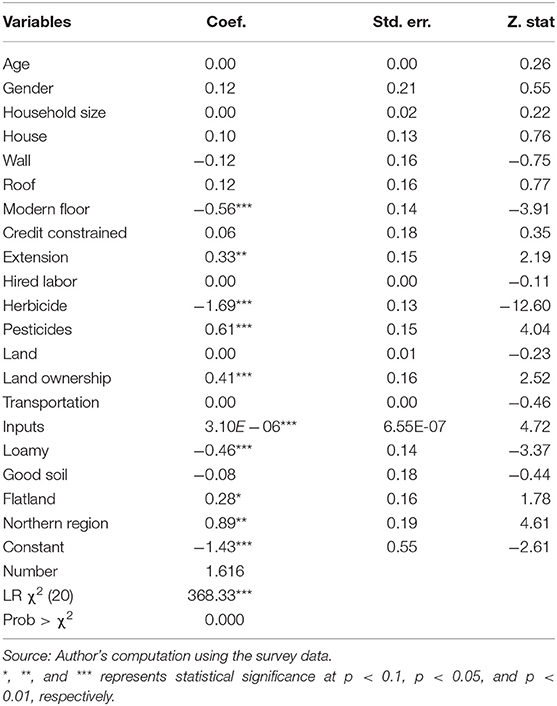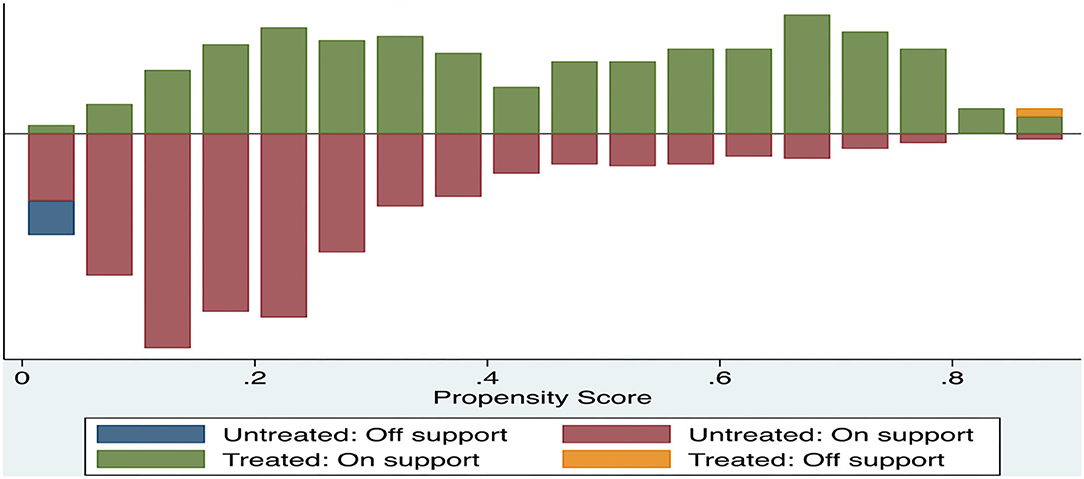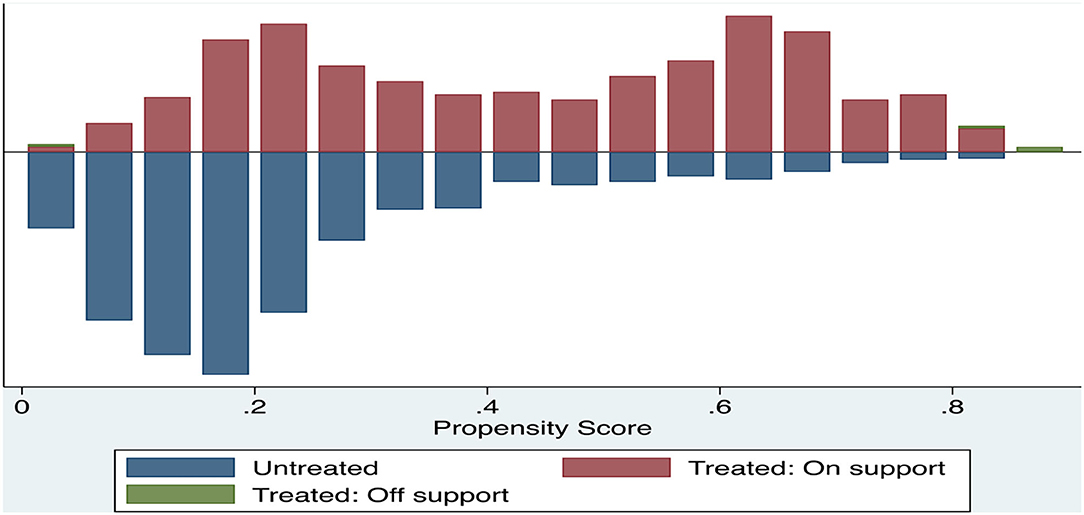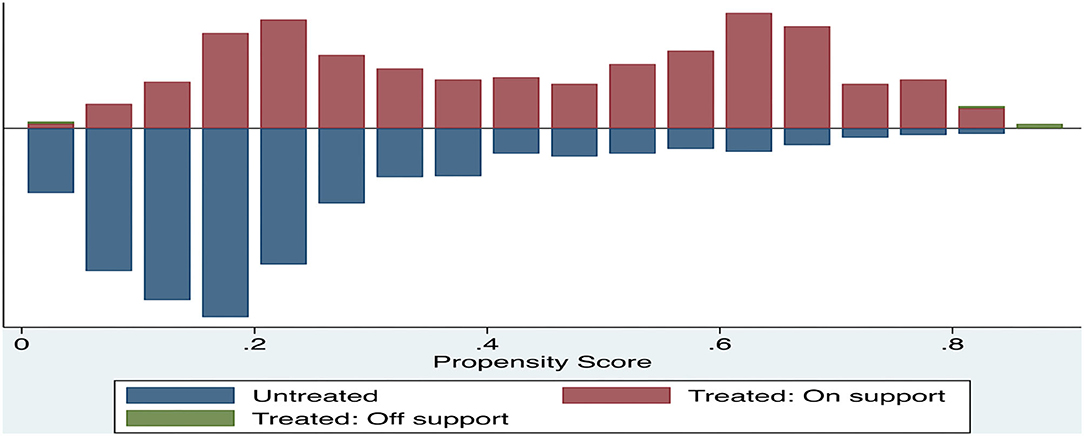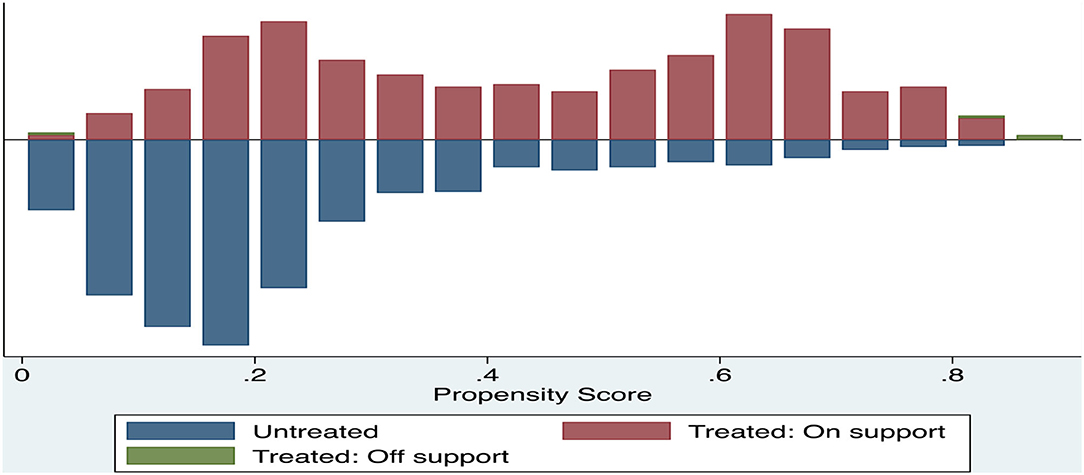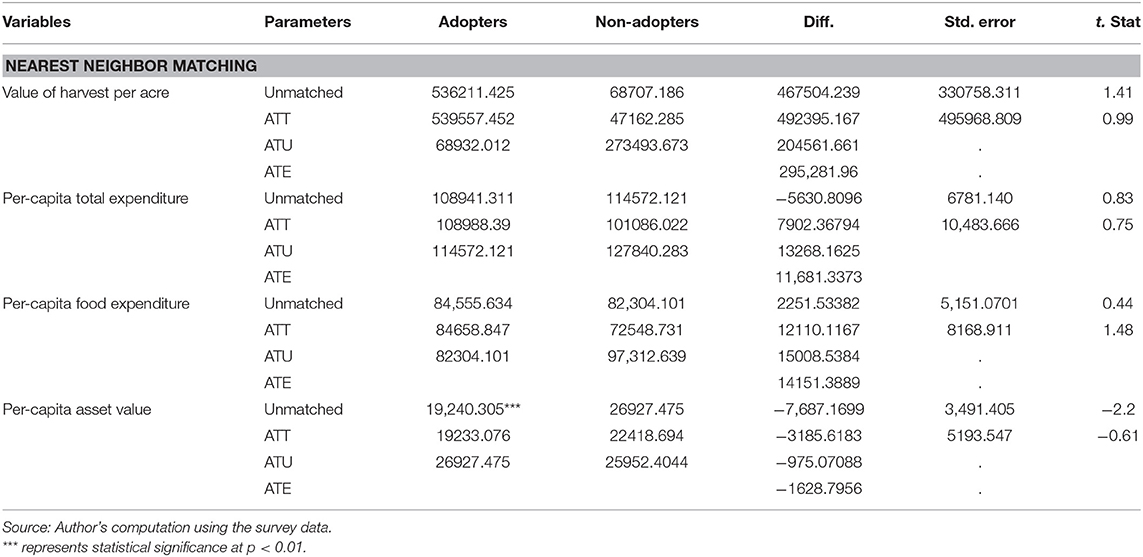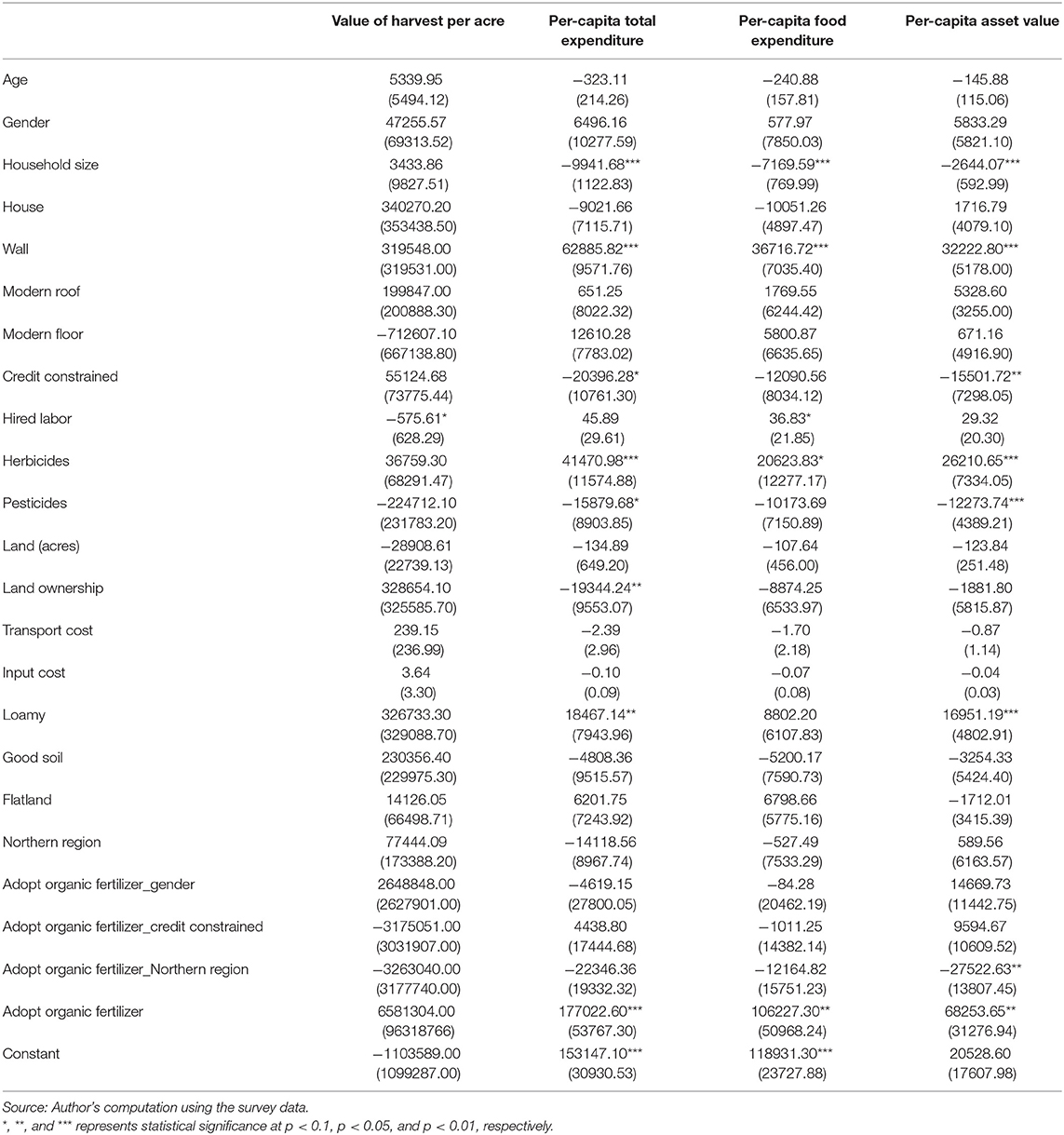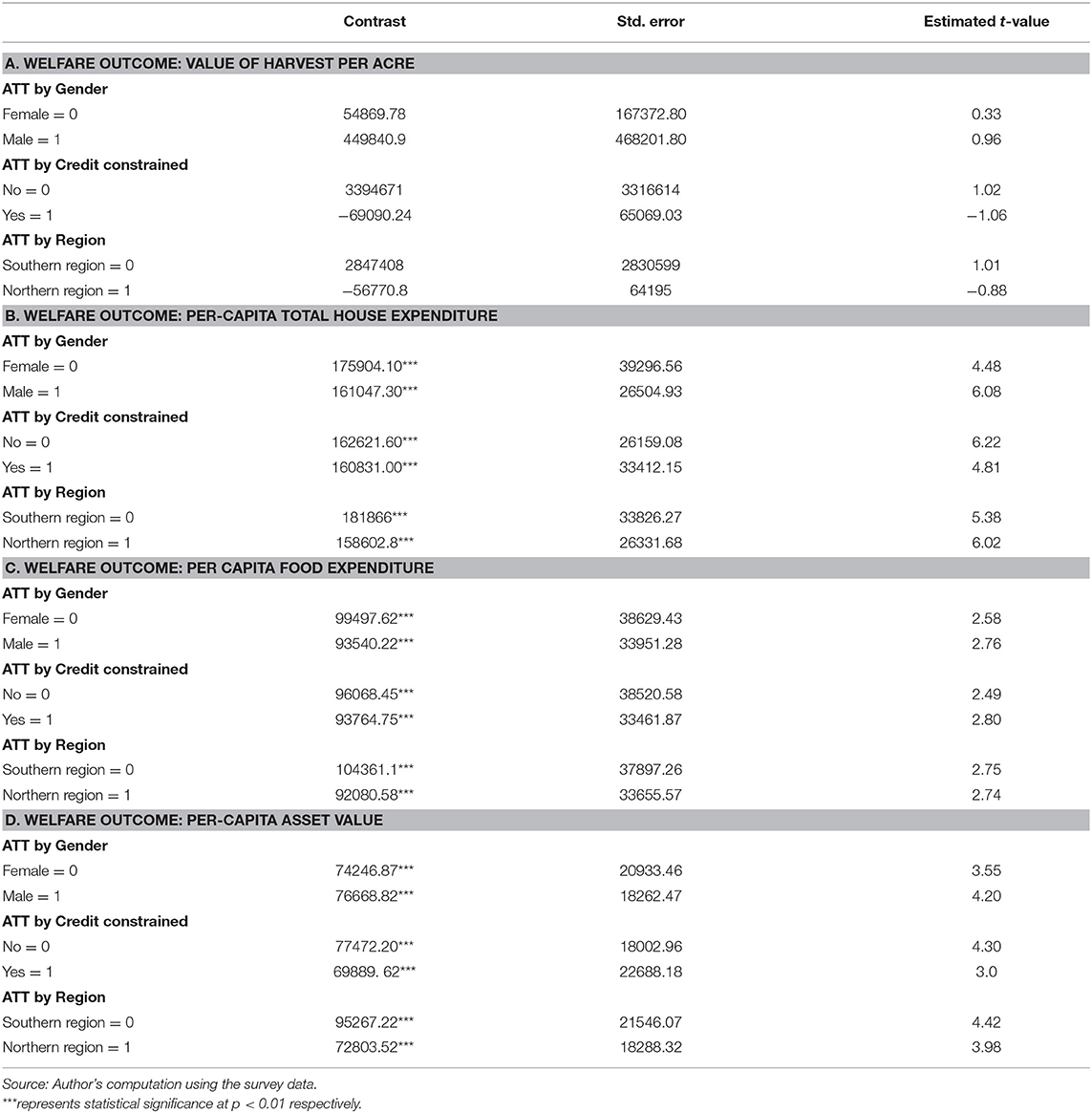- 1Natural Resources Institute, University of Greenwich, Chatham Maritime, Chatham, United Kingdom
- 2Rural Economy and Development Programme, Teagasc, Mellows Campus, Galway, Ireland
- 3Economics Research Branch, Agri-Food and Biosciences Institute, Belfast, United Kingdom
- 4Department of Agricultural and Applied Economics, University of Reading, Berkshire, United Kingdom
- 5Department of Agricultural and Resource Economics, Federal University of Technology, Akure, Nigeria
Soil fertility depletion is acknowledged to adversely influence agricultural productivity and welfare status of rural farming households. Studies have shown that organic fertilizer utilization tends to rejuvenate the soil, thereby enhancing its productive capacity. This study seeks to estimate the welfare impact of organic fertilizer adoption among agricultural households using the 2018/2019 Nigeria General Household Survey (GHS). The novelty of this study is in the use of propensity score matching (PSM) and endogenous treatment regression (ETR) to address biases that may arise from both observed and unobserved factors. Results show that the adoption of organic fertilizers positively and significantly impacts the welfare of farmers, particularly when sources of unobserved characteristics of agricultural households are accounted for. The heterogeneity impact results show that female household heads, agricultural households that had access to credit, and farm household residents in the southern region of Nigeria significantly gained more from the adoption of organic fertilizers. In addition, a check for time effect reveals that the adoption of organic fertilizers does not result in an immediate welfare effect; the effect is, however, positive and significant over time. This suggests that adoption does not only improve soil and mitigate against climate impact, but it also has a higher likelihood of providing long-term and sustainable welfare impact for agricultural households. The results point to the need for policies and programs to promote and sustain the adoption of organic fertilizers among agricultural households through addressing existing institutional barriers such as extension and credit facilities.
Introduction
The continuous decline in soil nutrients and organic matter is not uncommon in Africa, and evidence showed that about 40% of Africa's soils are under degradation (FAO, 2015). The immediate and persisting long-term effect of soil fertility depletion is apparent in low agricultural productivity and poor rural agricultural households' welfare (Amare et al., 2017). It is also considered as one of the main biophysical factors limiting per capita food production (Kassie et al., 2013). In Nigeria, prevailing highly weathered soils are susceptible to leaching and degradation (Shehu et al., 2015). Experimental studies on farmlands across various zones in the country have shown depleting macronutrients such as nitrogen, phosphorus, and potassium and micronutrients such as zinc, magnesium, and iron (Shehu et al., 2015) and high acidity and deficiency in soil organic matter (Salami, 2013). Poorly weathered soils are partly related to unsustainable use of chemical fertilizers (FAO, 2010) coupled with the direct impact of climate threat such as drought (Azeez et al., 2005; Abaje et al., 2013) and have implications on agricultural households' productivity and welfare outcomes (Barry et al., 2014; Ray et al., 2018; Wang et al., 2020).
Organic fertilizer is one of the revolutionary components of sustainable agricultural practices in tackling soil fertility depletion (FAO, 2010). By definition, organic fertilizers comprise a variety of plant and animal matter ranging from fresh or dried plant material to animal manures, litters, and agricultural by-products and are rich in carbonic content (Singh, 2012). Experimental evidence has, however, shown that adopting organic fertilizers does not only increase yield but also increases the soil bulk density, soil organic matter, and essential soil minerals such as nitrogen, phosphorus, potassium, calcium, and magnesium (Agbede et al., 2019). Besides increasing yield potentials, organic fertilizers improve the physical structure and biochemical activity of the soil, and its effect is long-term through the gradual decomposition of the soil organic matter (Li et al., 2017). Likewise, it is one of the environmentally long-term approaches to achieving sustainable agriculture and is economically feasible (Li et al., 2017).
Despite its importance, the adoption of organic fertilizers is yet to receive similar recognition like chemical fertilizers that are still traditionally used by small farm households (Powell, 1986; Quynh and Kazuto, 2018). Limiting factors to adopting organic fertilizers include the perception of slow release of nutrients (Khaliq et al., 2006), labor-intensive (Adnan et al., 2017), extension failures, poor knowledge of use, and lack of understanding of the benefits of organic fertilizers (Cai et al., 2019). Studies have further explored other socioeconomic factors of the adoption of components of organic fertilizers as a sole practice and in interdependent scenarios with other sustainable agricultural practices (Teklewold et al., 2013; Kassie et al., 2015; Wainaina et al., 2016; Oyetunde-Usman et al., 2021). While these approaches are important in eliciting policies to improve on factors that can increase the adoption of organic fertilizers, there are limited studies on understanding the adoption impact of organic fertilizer. Although evident in earlier studies (Dawe et al., 2003; Masarirambi et al., 2010), a more recent study on the adoption impact of organic fertilizers is established in Martey (2018).
This study focuses on the impact of the adoption of organic fertilizers on agricultural households' welfare in Nigeria. In Nigeria, agriculture is predominantly rural, and it currently employs about 34.65% of the total employment (World Bank, 2020) and, in recent estimates, contributes about 30.77% to the country's GDP (National Bureau of Statistics, 2015). Agriculture continues to serve as the immediate source of staple food needs and revenue for the majority of rural households (Garzón Delvaux and Gomez y Paloma, 2018). The agricultural sector is, however, riddled with low welfare returns to agricultural households as a result of low productivity (Oseni et al., 2014). Among several other factors, poor soil fertility is one of the underlying factors contributing to low agricultural productivity (Donkor et al., 2019). This is exacerbated by the continuous impact of the climate change effect (Onyeneke et al., 2018), which is evident in increasing drought and desertification in agricultural arable lands (Abaje et al., 2013), implying nutrient loss and toxicities to crop yield (Nkonya et a., 2016). While it is vital for agricultural households to adopt yield-enhancing techniques to ensure crop yield, the adoption of organic fertilizers in Nigeria has received little attention, unlike chemical fertilizers which have received promotions under subsidy programs; an example is the Growth Enhancement Support Scheme (Wossen et al., 2017b).
While the resultant effect of the fertilizer subsidy program is important in increasing the already low consumption of fertilizer, this study, however, based its proposition on the need to also promote and sustain the use of organic fertilizers by assessing the impact of adopting organic fertilizers on welfare outcomes in Nigeria. It establishes an attempt to comprehensively address key relevant policy questions relating to organic fertilizers using nationally representative data. Besides, the 2018/2019 wave of the Living Standard Measurement Survey (LSMS) data provides a more recent opportunity to explore the welfare impact of the adoption of organic fertilizers. Organic fertilizer in the context of this study is inclusive of green manure, compost, crop residue, and animal manure. We employed the propensity score matching (PSM) method and endogenous treatment regression (ETR) model to account for both observable and unobservable confounding factors affecting the adoption of organic fertilizers. The key policy questions addressed include the following: (1) what are the attributes that affect agricultural households' decisions to adopt or not adopt organic fertilizers? (2) Does the adoption of organic fertilizers improve agricultural households' welfare? Addressing these questions is central to the promotion of policies that address sustainable yield production and improve welfare in Nigeria and sub-Saharan Africa (SSA) as a whole. It is also important to note that agriculture is central to the economy of most developing countries and, in SSA, has been linked to welfare improvement (Christiaensen et al., 2011; Amare et al., 2017).
The rest of the paper is organized as follows: the second section describes the data, methods and empirical strategy, the third section reports the result, and the fourth section reports the major findings. Finally, the fifth section concludes the paper.
Data and Methods
Data
This study adopts cross-sectional data sourced from the 2018/2019 Nigeria General Household Living Standard Measurement Survey (NGH-LSMS), jointly conducted by the National Bureau of Statistics (NBS) (primary investigators), the World Bank (producers), and the Bill and Melinda Gates Foundation and the Federal Government of Nigeria (funding agency/sponsor). From previous waves, The General Household Survey (GHS) panel sample consists of 5,000 households across 500 enumeration areas (EAs) and was designed to be representative at the national level as well as at the zonal level. However, the current wave features a partial refresh GHS-Panel sample of randomly selected 360 EAs, which consisted of 60 EAs per zone, resulting in a total refresh sample of approximately 3,600 households. In addition to these 3,600 refresh households, a subsample of the original 5,000 GHS-Panel households from the first wave in 2010 was selected to be included in the new sample. The systematic selection ensured that the distribution of EAs across the six zones (urban and rural areas within) is proportional to the original GHS-Panel sample. The combined sample of refresh and long panel EAs consisted of 519 EAs. The total number of households that were successfully interviewed in both post-planting and post-harvest visits for 2018/2019 was 4,976. After merging of variables for this research paper and data cleaning including the exclusion of missing observations, this empirical analysis is based on 1,573 agricultural households.
The survey comprehensively covered households' agricultural information for the 2018/2019 agricultural season which includes socioeconomic attributes, adoption of organic fertilizers, access to credit and extension, soil quality status, and regional location of households among others. The description of all variables is presented in Table 1.
There are four main welfare outcome variables employed in this study, and these include the value of harvest per acre, total house expenditure, food expenditure, and asset value. The value of harvest per acre represents the crop income and was measured by dividing total value of harvest in the 2018/2019 agricultural season by the acre of lands under production. Besides, we considered households' expenditures as they are less vulnerable to underreporting bias compared with income (Meyer and Sullivan, 2003), and in line with similar impact studies (Wossen et al., 2017c; Abdoulaye et al., 2018), we adopt the per capita of total house expenditure and per capita of food expenditure as outcomes in this study, and these were, respectively, measured by dividing the total of each outcome by the number of household members. Also, we considered per capita of asset value measured by the total value of agricultural household assets divided by the number of household members. Asset value consists of monetary values of households' assets (television, radio, fridge, clothing items, jewelry, kitchen utensils, and furniture) owned in the 2018/2019 agricultural season. Poor welfare can be linked to a lack of assets (Haveman et al., 2000), and assets are less susceptible to random shocks and can be used to measure longer-term prospects of not being poor (Carter and Barrett, 2006).
The treatment variable is the adoption of organic fertilizer measured by a dummy which takes a value of 1 if an agricultural household adopts organic fertilizer in the 2018/2019 agricultural season and 0 otherwise. Wave 3 (2015/2016) of the Nigeria GHS originally presents the adoption of organic fertilizers which include plant- and animal-based manure, and this continues in the fourth wave (2018/2019). A panel analysis of the impact for two periods (2015/2016 and 2018/2019) would have been more preferable; however, due to many missing observations for the dependent and independent variables for the two periods, this study first considers using nationally representative data from the recent wave to assess adoption impact of organic fertilizers on welfare status of agricultural households. Few households from balanced panel data for the two periods (2015/2016 and 2018/2019) were used as a check to test impact when time effect is accounted for.
Empirical Strategy
Adoption Decision and Household Welfare
Suppose the treatment indicator Ti represents the decision to adopt or not adopt organic fertilizer by rural agricultural households which is assumed to be dependent on households' perceived utility. Considering that the adoption of organic fertilizers is likely to impact outcomes of productivity and households' welfare, these outcomes, however, form a linear function of agricultural households' observed vector of explanatory variables including the dummy variable explaining their choice of adoption which is expressed as:
where Yi represents the outcomes of productivity and welfare outcomes; Xi represents the explanatory variable which includes agricultural households' socioeconomic, land, and regional attributes; Ti is the treatment indicator for agricultural households' adoption decisions; ϑ is the vector of parameters of the explanatory variables to be estimated; σ represents the vector of parameter estimates of adoption impact of organic fertilizers; and μi is the error term. Estimating the true causal impact of the adoption of organic fertilizers is not trivial, and this estimation approach presented in Equation (1) will generate bias due to non-accountability for endogeneity bias. Selectivity bias arises when the observed and unobserved characteristics of agricultural households affect the likelihood of receiving treatment and also affect their outcome indicators. As an example, the managerial skills of farmers cannot be observed but may influence both farmers' welfare as well as their decisions to use fertilizers or otherwise.
In this study, we adopt PSM to correct for selectivity bias due to observables. The PSM approach generates propensity scores which are estimates of agricultural households' propensity to adopt organic fertilizers as a function of their observable characteristics. This approach mimics the randomized control approach to remove selectivity bias. Besides, parameters of the average treatment effect (ATE) and average treatment on treated (ATT) can be estimated through matching methods. The difference between the ATE and ATT is that while the ATE estimates the average improvement by all members of the population under study, the ATT estimates impact differences in the subpopulation of agricultural households that adopt a particular agricultural technology or practice; in other words, the ATT estimates the question, “How would the welfare level of agricultural households have changed had adopters of organic fertilizers chosen not to have adopted organic fertilizers?”
We adopt the nearest neighbor matching techniques which match non-adopters and adopters with the nearest propensity scores (Awotide et al., 2015). The parameters of interest in this study are the ATT which allows us to assess the welfare level of adopters of organic fertilizers had they chosen not to be in the treatment group. Following (Imbens and Wooldridge, 2009), the ATT is expressed as:
where Y(1) and Y(0) are outcome indicators of the value of harvest per acre, per capita of total house expenditure, per capita of food expenditure, and per capita of asset value. T represents the treatment indicator, equals 1 for adopters. However, the non-adoption status of adopters cannot be observed E[Y(1)|T = 0]; we can only observe E[Y(1)|T = 1]. To observe the counterfactual status of the treated class, the PSM creates a comparable counterfactual of households for the treated group from the already matched observable characteristics of households based on the assumptions that there is no systematic difference between their unobservable characteristics. Given the fulfillment of the conditional independence assumption illustrated as TY1, Y0 ⊥T/X, which means that conditional on observable characteristics of agricultural households (X), their welfare outcomes are independent of adoption of organic fertilizers, and the overlap condition which ensures that treatment observation has nearby comparison observations in the propensity score distribution and only in areas of common support can inferences be made about causality, then the ATT can be computed as follows:
The PSM is, however, only limited to assessing observables of agricultural households in generating estimates of ATT which may be biased due to the assumption of no differences in unobservable characteristics of agricultural households. In reality, differences in production and welfare outcomes can be dependent on unobservable innate abilities and motivations of agricultural households. For a more robust approach and consistent estimate of the impact of the adoption of organic fertilizers on outcomes of interest, we considered adopting the linear endogenous treatment effects akin to approaches adopted to account for unobservable characteristics of agricultural households (Awotide et al., 2015; Adebayo et al., 2018; Anang et al., 2020). The ETR model does not only remove bias from observables and unobservables, but it also enables us to simultaneously estimate the determinants of adoption of organic fertilizers and the direct impact of the adoption of organic fertilizers on welfare outcomes by jointly estimating one selection equation which models agricultural households decision to adopt organic fertilizers and one outcome equation which models the impact of the adoption of organic fertilizers on welfare outcomes (Hübler, 2016).
We derived the selection equation by assuming that farmers make adoption decisions on whether or not to adopt organic fertilizers based on the expected net returns. Suppose the expected net returns from adopting and not adopting organic fertilizers are, respectively, represented as TU and TV, a rational agricultural household will only choose to adopt organic fertilizer if the expected net return difference from adoption and non-adoption is greater than 0, that is: . Since cannot be observed directly, it can be expressed as a latent variable model as follows:
Where Tt is the treatment variable which equals 1 if an agricultural household adopts organic fertilizer in the past agricultural season and 0 otherwise. Xt is the vector of household, farm level, and regional characteristics; ∂ is the vector of parameters to be estimated; and μt is the error term. The ETR model essentially involves two stages: the first stage identifies households' decisions to adopt organic fertilizers based on the observables augmented by a binary endogenous treatment variable and is expressed as follows:
In addition to the identification of variables and parameters above, Wt refers to the binary instrumental variable used for model identification in the ETR model estimation and φ is the parameter to be estimated. In our study, we augmented this model with a variable that indicates that households received advice from extension agents on improved production practices in the past agricultural season. Access to information on sustainable agricultural practices and extension access is endogenous to the adoption of sustainable agricultural practices (Manda et al., 2016; Martey et al., 2020). In the second stage, the outcomes of the interest equation are specified and linked to the selection equation indicating factors influencing adoption while controlling for the potential endogeneity associated with the adoption of organic fertilizers. The second stage is specified as follows:
Where Yt represents the outcomes of production (value of harvest per hectare) and welfare (per capita of the total household, food, non-food, and asset value); Zt is a vector of households, farm, and regional characteristics that are expected to affect the decision to adopt organic fertilizer; and βt and μt represent the vector of parameters to be estimated and the error term, respectively. The error terms μt and ϵt are bivariate normal with mean zero and covariance matrix.
Also, the covariates of the selection and outcome equations Xt and Zt are unrelated to the error term. We estimated the ATE and ATT of adopting organic fertilizer using the “etregress” maximum likelihood approach in Stata 15. This function estimates an ATE and the other parameters of a linear regression model, augmented with an endogenous binary treatment variable using a maximum likelihood approach. We estimated ATE and ATT with and without including covariates interaction. When there are no interactions between the treatment variable and the outcome covariates, the etregress function directly estimates the ATE and the ATT; in this case, the ATE and ATT are the same. In the second scenario, we interacted the model with households' attributes of credit constraint, gender, and regional variables and as such estimated the ATT specifying that the model solely considers the subpopulation of adopters of organic fertilizers using the margins command. We further assessed the heterogeneous impact of the adoption of organic fertilizers within adopters across households' credit constraint status, gender, and regional location of agricultural households.
With balanced panel data for 454 agricultural households for the 2015/2016 and 2018/2019 waves of the LSMS data, we check for time effect on adoption impact of organic fertilizers by applying a panel difference-in-difference estimation (DID). The DID for agricultural households for two time periods t is stated as follows:
Where represents the welfare status of adopters of organic fertilizers in the 2018/2019 agricultural season; is the welfare status of adopters of organic fertilizers in the 2015/2016 agricultural season. represents the welfare status of non-adopters of organic fertilizers in the 2018/2019 agricultural season and represents the welfare status of non-adopters of organic fertilizers in the 2015/2016 agricultural season.
Summary Statistics of Variables
Table 2 presents the summary statistics of agricultural households' attributes and the mean difference between adopters and non-adopters. The data show that the average age of the household head is 50 years, and the average household size is 7. Moreover, 83% of the respondents are male household heads. In terms of farm characteristics, the average land area is 2.62 acres suggesting that the majority are smallholders with about 76% tenure-secured farmlands. Smallholder farmers spent NGN813.20 on average on transportation cost to the nearest input market. Also, about NGN30,207.81 on average is spent on total input acquired in the past agricultural season. The data also show that on average about 14 and 40% applied pesticides and herbicides, respectively. Wealth indicators show that 40% on average own a house, 43% have a modern wall covering on their house, 77% use a modern roof, and 66% have protective cemented flooring. The descriptive statistics also show that on average 76% perceived the soil quality of their plot to be good, 66% of farm households' plots are flatland, and 46% of agricultural household soil are loamy soil. Access to institutional services reveals that only 19% and 15% on average, respectively, received advice from extension agents and had access to credit in the past agricultural season.
Table 2 further presents differences in the means of all covariates between adopters and non-adopters of organic fertilizers. The significant difference between adopters and non-adopters of organic fertilizers is evident in covariates of institutional access, farm, and other household attributes. For example, there is a significant mean difference of 12% between adopters and non-adopters of organic fertilizer in terms of access to extension services. Similarly, while 18% and 15% of adopters and non-adopters were credit constrained, the significant mean difference of 3% surprisingly shows that most adopters are credit constrained, and this may play a role in the adoption of organic fertilizers. In line with a previous study, where chemical fertilizer subsidy is available, the adoption of inorganic fertilizer has been found to crowd out the adoption of organic fertilizers, and where agricultural households do not have access to such subsidy, they tend to adopt organic fertilizers (Alabi et al., 2016). In terms of farm factors, the majority of non-adopters have better soil status and quality with less sloppy land areas compared with adopters. On assessing distribution based on region, the majority of agricultural households adopting organic fertilizer are located in the northern region, inclusive of about half of non-adopters of organic fertilizers.
For the outcome variables, the mean difference between adopters and non-adopters is positive but only statistically significant for per-capita asset value. It is important to note that the mean difference results cannot solely be used to make inferences on the impact of the adoption of organic fertilizers on outcomes of interest without controlling for other confounding factors. Figures 1–4 present the kernel distribution showing variation in skewness between adopters and non-adopters across the outcome variables.
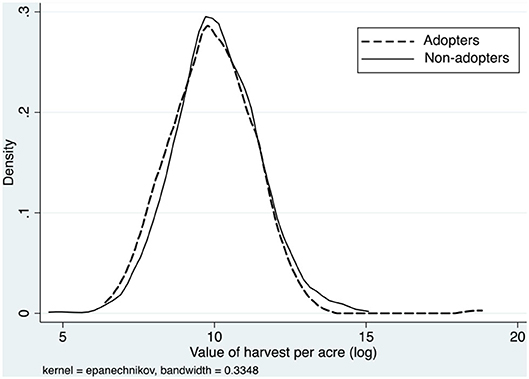
Figure 1. Kernel density distribution of the log of value of harvest per acre for adopters and non-adopters of organic fertilizers.
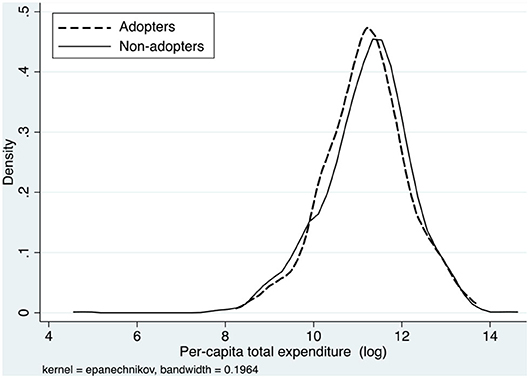
Figure 2. Kernel density distribution of the log of per-capita total house expenditure for adopters and non-adopters of organic fertilizers.
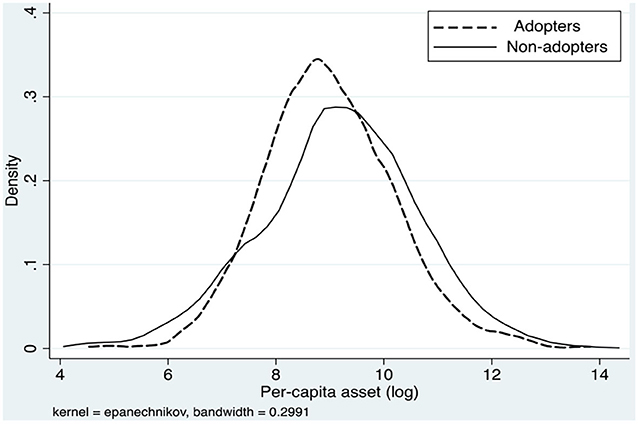
Figure 3. Kernel density distribution of the log of per-capita asset value for adopters and non-adopters of organic fertilizers.
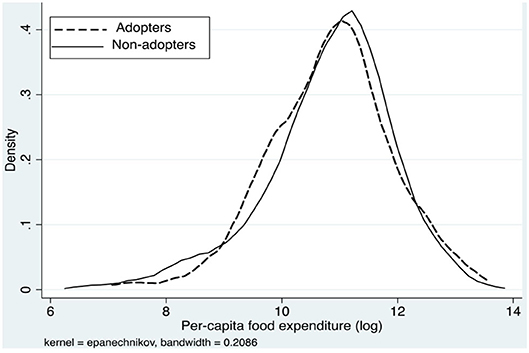
Figure 4. Kernel density distribution of the log of per-capita food expenditure of adopters and non-adopters of organic fertilizers.
Results
Determinants of Adoption of Organic Fertilizers
Table 3 presents the results of the factors influencing the adoption of organic fertilizers using the logit model. The overall model is statistically significant at p < 0.01 with a chi-square value of 368.33, suggesting that the adoption of organic fertilizer is strongly associated with agricultural households' socioeconomic, land, and regional variables. Land ownership has a positive and significant effect on the adoption of organic fertilizer. Similar to studies on sustainable land practice, long-term investments are more associated with agricultural households that are tenure secured (Abdulai et al., 2011; Ogunpaimo et al., 2021; Oyetunde-Usman et al., 2021). Also, access to extension services significantly impacts the adoption of organic fertilizer, and this is related to adoption studies that found extension endogenous to adoption (Wossen et al., 2017a). Variations exist in the adoption of organic fertilizer and other sustainable agricultural practices; from the result, while the use of pesticides increased the adoption of organic fertilizers, the use of herbicides reduced the propensity to adopt organic fertilizers. In contrast to the results on herbicides used in this study, a downside adoption of organic fertilizer is the rapid promotion of weed growth which may require farmers' need to use herbicides (Giller et al., 2009).
Also, agricultural households with soil types other than loamy soil are more likely to adopt organic fertilizers. This suggests that poor soil quality can drive the adoption of organic fertilizers. This is in line with the findings that adopters of organic fertilizers generally perceived their soil quality to be poorer than non-adopters and are more willing to adopt organic fertilizers to improve soil quality (Chen et al., 2018) which can significantly increase crop output (Olagunju et al., 2021). The result further reveals that organic fertilizers are more likely to be adopted on flatland compared with sloppy land areas. In contrast, adoption of similar soil and water conservation practices has been found common among agricultural households with farmlands on steep slopes (Bedeke et al., 2019). In addition, regional differences exist in the adoption of organic fertilizer, and the likely explanation can be linked to the concentration of agricultural activities in the northern savanna region, and in retrospect, pastoral activities such as farm animal rearing are quite dominant in the northern region and have always been part of agricultural activities, and as such, manure for cropping is a traditional management practice (Powell, 1986). Among variables indicating the wealth status of agricultural households, the coefficient of agricultural households with modern floor is negative and significant indicating that poorer households have a higher probability of adopting organic fertilizers. The result further shows that adopters of organic fertilizers are more likely to incur more input costs compared with non-adopters. This cost may be related to labor cost, and in relation to similar studies on related sustainable agricultural practices, land management practices require high labor demand (Adnan et al., 2017).
Impact of Adoption of Organic Fertilizers on Welfare Outcomes: Propensity Score Matching
We first assessed the impact using the PSM approach which only considers impact based on observables. Figures 5–8 show the matching propensity score distribution and common support for propensity score estimation. In the figures, the “treated and untreated: on support” indicates the observations in the adoption group that have a suitable comparison, while the “treated and untreated: off support” indicates the observations in the adoption group that do not have a suitable comparison. From the result in Table 4, the returns on adoption for adopters (ATT) are only positive for all outcomes of interest, except for per-capita asset value, but not significant. The non-significance estimates in the PSM may suggest the presence of other unobservable confounding factors that may be affecting the adoption of organic fertilizers, which are not accounted for in the PSM.
Linear Estimates of the Endogenous Treatment Switching Regression Model
Table 5 presents the coefficient estimates of the ETR when the covariates of credit access, gender, and agroecological zone are interacted with the treatment variable in the model (second stage). The estimated ATT was derived using the margins function. The ATE was derived from the coefficient estimates of ETR without interaction and the selection equation for the model is presented in the Supplementary Material (Appendix A1–A4). The parameter estimates of the ATE and ATT are jointly presented in Table 6, while the heterogeneity of ATT among adopters over their gender, credit status, and agroecological location is presented in Table 7.
The estimates of linear ETR presented in Table 5 show a significant increase in the mean of per capita of total house expenditure, food, and asset for agricultural households with fewer household members and who are not credit constrained and adopt herbicides. In contrast, the use of pesticides was negative and significant for the outcomes of per-capita total house expenditure and asset value. Indicators of wealth such as modern wall show significantly impact means of outcomes of per capita of total house expenditure, food, and asset. The result further shows a significant increase in the mean of per-capita total house expenditure for households with loamy soil. This may be related to the causal effect of soil fertility on increasing productivity and farm income (Raimi et al., 2017). The result on labor use is quite mixed: while it was positive and significant for the mean of the value of harvest per acre, it was positive and significant for the outcome of per-capita food expenditure.
Impact of Adoption of Organic Fertilizers on Welfare Outcomes Using the Endogenous Treatment Regression Model
As illustrated in Table 6, the ATE and ATT are almost the same. The ATE shows that returns on the adoption of organic fertilizer significantly (p < 0.01) increased by NGN162,697.50, NGN77,002.80, and NGN94,341.49, respectively, for outcomes of per-capita total house expenditure, per-capita asset value, and per-capita food expenditure. The ATT shows that the welfare impact of treated households significantly increased by NGN162380.60, 76,451.67, and 94,074.86, respectively, for outcomes of per-capita total house expenditure, per-capita asset value, and per-capita food expenditure. This result is in line with previous studies on the adoption of organic fertilizers; for example, Martey (2018) shows that the adoption of organic fertilizers positively impacts agricultural households' welfare.
Heterogeneous Impact of Adoption of Organic Fertilizers
Table 7 further illustrates the ATT by gender, credit access, and regional location of the agricultural household. Estimates of ATT by gender show that returns on welfare outcomes are significantly higher for female households' heads for outcomes of per-capita total house and food expenditure except for per-capita asset value where it is higher for the male household head. To highlight, per-capita total house expenditure is higher for female household heads (NGN175,904.10) than male households head (NGN161,047.30) which translates to 8.5% differences in ATT. Similarly, returns on per-capita food expenditure are higher for the female household head (NGN99,497.62) than male household heads (NGN93,540.22), translating to a 6% difference in ATT. Results based on these two outcomes show that female household heads benefit most from the adoption of organic fertilizers than male households.
In Table 7, coefficients of the ATT are higher for agricultural households that were not credit constrained in the past agricultural season, and this is positive and significant for all outcomes. To highlight, within the subpopulation of adopters of organic fertilizers, agricultural households that had access to credit in the past agricultural season received higher return on per-capita asset value (NGN77,472.20) than agricultural households that were credit constrained (NGN69,889.62), and this translates to 9.78% difference in ATT. Similarly, the returns on the per-capita total house and food expenditure are, respectively, 1.1% and 2.4% higher ATT for agricultural households that are not credit constrained. This result is in line with findings in Awotide et al. (2015) which shows that credit access plays a significant role in the gain from the adoption of improved cassava varieties. This result provides the need for flexible credit policy instruments for agricultural households.
The result further shows significant differences in ATT among adopters of organic fertilizers in the northern and southern regions. Agricultural households in the southern region had significantly higher returns for all outcomes than households in the northern region. The differences for all outcomes are 12.8, 11.8, and 23.5% higher for per-capita outcomes of house, food, and asset, respectively. This may be due to the high humidity and rainfall pattern in the southern region as organic manure requires adequate water in activating essential nutrients, controlling salinity (Li et al., 2020).
Check for Time Effect on the Adoption of Organic Fertilizers
Panel Difference-in-Difference Estimation of the Adoption of Organic Fertilizers
The results presented in Table 8 show panel difference-in-difference estimations for two periods (2015/2016 and 2018/2019) with and without covariates. Excluding covariates, the gain from adopting organic fertilizers significantly decreases in all outcome models. Also, the coefficient of the time variable shows that farm households' welfare outcomes significantly increase over time, except for the value of harvest per acre outcome. The panel DID estimates are interpreted as the interaction of the adoption of organic fertilizer variable with the time variable and significantly show that considering the time trend the gain from adopting organic fertilizers is positive and significant for all outcomes.
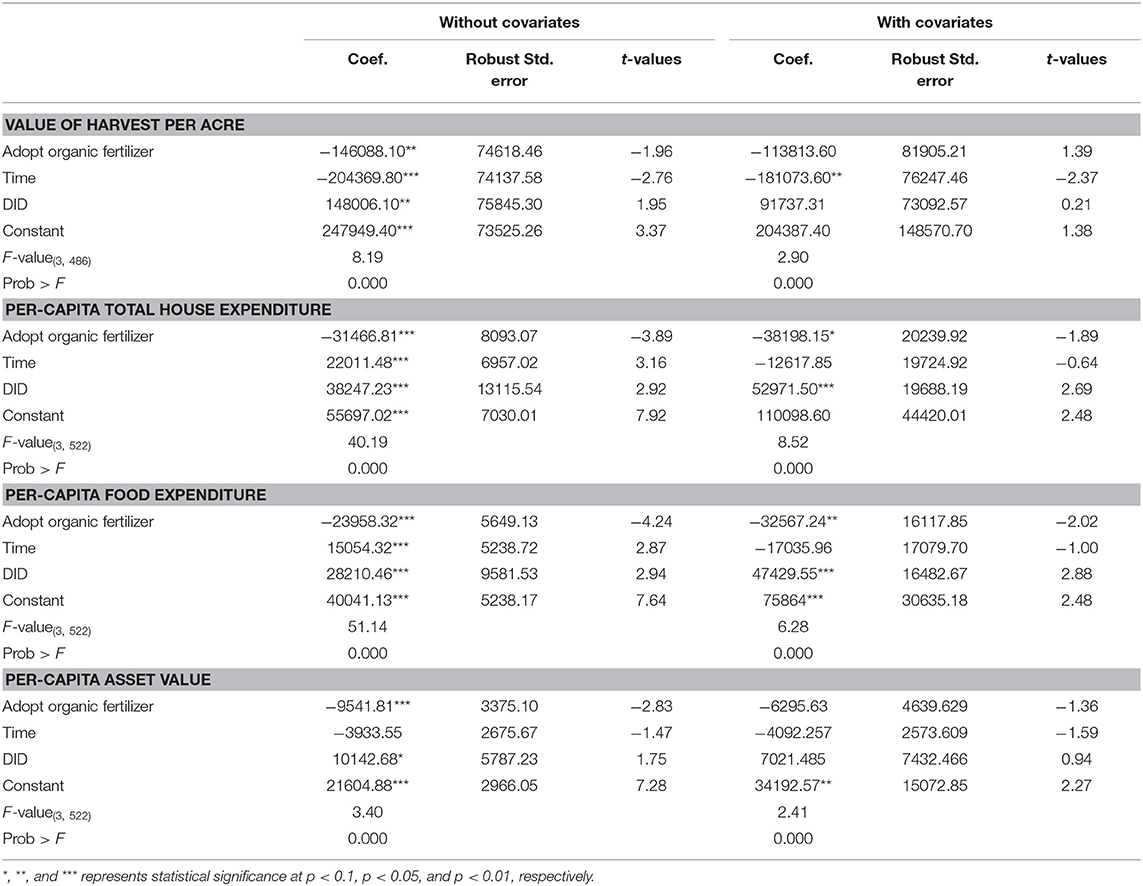
Table 8. Check for Time Effect: Panel difference-in-difference estimates of organic fertilizers adoption.
To highlight, farm housheolds that adopted organic fertilizers significantly gained NGN148006.10, NGN38247.23, NGN28210.46 and NGN10142.68 respectively for outcomes of value of harvest per acre, per-capita total house expenditure, per-capita food expenditure and per-capita asset value.
In the case where covariates are included in the model, we found a similar negative and significant decrease in the adoption of organic fertilizer; however, when the time trend is considered, the DID show a positive and significant increase of NGN52,971.50 and NGN47,429.55 for outcomes of per-capita total house expenditure and per-capita food expenditure respectively. The DID is only positive showing an increase of NGN7,021.49 for the outcome of per-capita asset value, however not significant. This shows that agricultural households that adopted organic fertilizers in the 2015/2016 and 2018/2019 agricultural season significantly gained as time trends upward. From this result, one can conclude that the gain from adopting organic fertilizers is not immediate but beneficial in the long term. This is in line with the perception that the gain from adopting organic fertilizer is slow (Khaliq et al., 2006; Chen et al., 2018).
Discussion
Using nationally representative data from Nigeria, this study assesses the welfare impact of adopting organic fertilizers among agricultural households in Nigeria. To contribute to the large body of empirical research on sustainable agricultural practices (Kassie et al., 2013; Teklewold et al., 2013; Arslan et al., 2014; Oyetunde-Usman et al., 2021), this study first assessed the determinants of adopting organic fertilizers and found that agricultural households that own lands and are perceived to be tenure secured have a higher probability of adopting organic fertilizers. Tenure security remains valid in farmers' decision to adopt soil and land investment agricultural practices in SSA (Abdulai et al., 2011; Lovo, 2016). This informs policy needs for flexible reform in land tenancy agreements to address the gap between users and owners of lands in order to encourage the adoption of organic fertilizers.
Furthermore, the study finds that agricultural households with poorer soils tend to use organic fertilizers more. This suggests that organic fertilizers are perceived as soil amendment practices for ensuring crop productivity. As such, it is required that policy programs enlighten non-adopters on the potential of organic fertilizers in promoting soil quality. In empirical studies, access to extension services is endogenous to the adoption of agricultural technologies and practices (Emmanuel et al., 2016; Wossen et al., 2017a). In line with this, our result reveals a significant impact of access to extension advice in promoting the adoption of organic fertilizers. In a similar study using soil- and land-improving techniques, participation in training in the use of organic fertilizers through extension platforms was instrumental to adoption (Daadi and Latacz-Lohmann, 2020). This result highlights the role of information and training in boosting the adoption of organic fertilizers. Additionally, we find that the adoption of organic fertilizers is highly probable in the northern agricultural region; however, gains from the adoption of organic fertilizers are higher among agricultural households in the southern region. While this shows the need to equally promote and sustain the adoption of organic fertilizers in both agricultural regions, it also points to the need for further studies to assess the efficiencies in the use of organic fertilizers and a need for comprehensive information on organic fertilizers in order to understand the differential in gains in adoption. This can as well inform policies on various promotion strategies to adopt. The result on increased input costs among adopters of organic fertilizers shows the need for flexible credit policy platforms to help farmers access and acquire input needs easily.
While it is important to assess the predictors of adoption of organic fertilizers, a further check on its welfare impact gives credence to its relevance in sustainable agricultural development and global sustainable development goals. Controlling for endogeneity in line with similar studies (Awotide et al., 2015; Adebayo et al., 2018), we find that adopters of organic fertilizers gained more in terms of their per-capita total house, food, and asset expenditures compared with non-adopters. This implies that the adoption of organic fertilizers is beneficial and informs the need to increase promotions of organic fertilizers among agricultural households through various agricultural policies and programs and reforms as it is critical for the welfare of agricultural households in Nigeria. It further points to the need to give similar awareness platforms to organic fertilizers and incorporate them into the fertilizer subsidy schemes in agricultural policies and programs in Nigeria. In addition, promoting and sustaining the adoption of organic fertilizers is equally important for ensuring sustainable agricultural ecosystems. As such, there will be a need to prioritize awareness and training on the effective and efficient use of organic fertilizers through extension services platforms.
We further assessed the heterogeneity in impact across key socioeconomic factors, and this includes gender, credit access, and agricultural household location based on region. We found significant heterogeneity among adopters of organic fertilizers, in which female household heads, the household that had access to credit, and household residents in the southern region gained more from adopting organic fertilizers. This finding underscores the need for policy measures to promote the adoption of organic fertilizers more among male household heads and create accessible and flexible credit facilities.
While these results are relevant, results should be carefully interpreted. The impact study uses large cross-sectional data which do not account for the time effect that is likely to influence results. Although we applied a check for time effect which is limited to very few households for two periods, there will be a need for more comprehensive panel data to fully adjudge the welfare impact of adopting organic fertilizers. Future studies may also need to use panel data to assess the predictors of adopting organic fertilizers and also considering its interrelationship with other sustainable practices such as chemical fertilizers. This can also include comparing welfare impact variation in sole cases and in combinations. This will likely explain the policy pathways to incorporating organic fertilizers in existing fertilizer subsidy programs in Nigeria.
Conclusion
Poor soil fertility is one of the problems of low productivity in SSA countries, and sustainable agricultural practices remain key to improving soil and providing long-term welfare impact. In Nigeria, policy programs on improving the adoption of organic fertilizers are yet to receive so much recognition unlike other yield-enhancing practices such as chemical fertilizers. In the quest to promote sustainable agricultural practices, the adoption of organic fertilizers doubles as a way of not only increasing agricultural yield but also contributing to sustainable agroecosystems.
This study finds determinants of the adoption of organic fertilizer to include land ownership, extension access, poor soil quality, and regional differences. The impact result shows that adopters of organic fertilizers are better off in terms of their welfare status, compared with non-adopters. Within the agricultural households that gained from adopting organic fertilizers, this study finds existing heterogeneous impact showing that female household heads gained more from adopting organic fertilizers and agricultural households that are not credit constrained are better off as well. A check for time-variant effect further reveals that gain from adoption is not immediate and impact tends to increase with time.
The results of this study underscore the importance of promoting and sustaining the adoption of organic fertilizers through various dissemination platforms, and it most importantly highlights the need to remarkably incorporate promotions of organic fertilizers in existing fertilizer subsidy policies and programs.
Data Availability Statement
The datasets presented in this study can be found in online repositories. The names of the repository/repositories and accession number(s) can be found below: The data used for this study is publicly available and can be found here: https://microdata.worldbank.org/index.php/catalog/3827.
Author Contributions
ZO-U conceptualized, designed, and wrote the original draft, conducted the analysis, and coordinated all other submissions. ORO and KOO contributed to the methodology, review of the analysis, writing part of the result section, and review of the paper. OA and WA contributed to the writing and manuscript review and provided comments and additional inputs. All authors read, reviewed, and approved the submitted version.
Conflict of Interest
The authors declare that the research was conducted in the absence of any commercial or financial relationships that could be construed as a potential conflict of interest.
Supplementary Material
The Supplementary Material for this article can be found online at: https://www.frontiersin.org/articles/10.3389/fsufs.2021.691667/full#supplementary-material
References
Abaje, I. B., Ati, O. F., and Iguisi, E. O. (2013). Droughts in the sudano-sahelian ecological zone of nigeria : implications for agriculture and water resources development. Glob. J. Hum. Soc. Sci. Geogr. Geosci. Environ. 13, 1–10. Available online at: https://globaljournals.org/GJHSS_Volume13/1-Droughts-in-the-Sudano-Sahelian.pdf
Abdoulaye, T., Wossen, T., and Awotide, B. (2018). Impacts of improved maize varieties in Nigeria: ex-post assessment of productivity and welfare outcomes. Food Sec. 10, 369–379. doi: 10.1007/s12571-018-0772-9
Abdulai, A., Owusu, V., and Goetz, R. (2011). Land tenure differences and investment in land improvement measures: theoretical and empirical analyses. J. Dev. Econ. 96, 66–78. doi: 10.1016/j.jdeveco.2010.08.002
Adebayo, O., Bolarin, O., Oyewale, A., and Kehinde, O. (2018). Impact of irrigation technology use on crop yield, crop income and household food security in Nigeria: a treatment effect approach. AIMS Agric. Food 3, 154–171. doi: 10.3934/agrfood.2018.2.154
Adnan, N., Md Nordin, S., Rahman, I., and Noor, A. (2017). Adoption of green fertilizer technology among paddy farmers: a possible solution for Malaysian food security. Land Use Policy 63, 38–52. doi: 10.1016/j.landusepol.2017.01.022
Agbede, T. M., Adekiya, A. O., Ale, M. O., Eifediyi, E. K., and Olatunji, C. A. (2019). Effects of green manures and NPK Fertilizer on soil properties, tomato yield and quality in the forest-savanna ecology of Nigeria. Exp. Agric. 55, 793–806. doi: 10.1017/S0014479718000376
Alabi, R. A., Adams, O. O., and Godwin, A. (2016). Does Inorganic Fertilizer Subsidy Promote the Use of Organic Fertilizer in Nigeria? International Food Policy Research Institute. (AGRODEP Working Paper 0036).
Amare, M., Cissé, J. D., Jensen, N. D., and Shiferaw, B. (2017). The Impact of Agricultural Productivity on Welfare Growth of Farm Households in Nigeria: A Panel Data Analysis. FAO. Available online at: http://www.fao.org/3/a-bp143e.pdf
Anang, B. T., Bäckman, S., and Sipiläinen, T. (2020). Adoption and income effects of agricultural extension in northern Ghana. Sci. Afr. 7:e00219. doi: 10.1016/j.sciaf.2019.e00219
Arslan, A., McCarthy, N., Lipper, L., Asfaw, S., and Cattaneo, A. (2014). Adoption and intensity of adoption of conservation farming practices in Zambia. Agric. Ecosyst. Environ. 187, 72–86. doi: 10.1016/j.agee.2013.08.017
Awotide, B. A., Alene, A. D., Abdoulaye, T., and Manyong, V. M. (2015). Impact of agricultural technology adoption on asset ownership: the case of improved cassava varieties in Nigeria. Food Sec. 7, 1239–1258. doi: 10.1007/s12571-015-0500-7
Azeez, J. O., Chikoye, D., Kamara, A. Y., Menkir, A., and Adetunji, M. T. (2005). Effect of drought and weed management on maize genotypes and the tensiometric soil water content of an eutric nitisol in south western Nigeria. Plant Soil 276, 61–68. doi: 10.1007/s11104-005-3864-1
Barry, B., Borgemeister, C., Lamers, J., Ouattara, M., Sédogo, L., and Vlek, P. (2014). WAS CAL Report 2010–2014. Federal Ministry of Education and Research, Germany.
Bedeke, S., Vanhove, W., Gezahegn, M., Natarajan, K., and Van Damme, P. (2019). Adoption of climate change adaptation strategies by maize-dependent smallholders in Ethiopia. NJAS Wagen. J. Life Sci. 88, 96–104. doi: 10.1016/j.njas.2018.09.001
Cai, T., Steinfield, C., Chiwasa, H., and Ganunga, T. (2019). Understanding Malawian farmers' slow adoption of composting: stories about composting using a participatory video approach. Land Degrad. Dev. 30, 1336–1344. doi: 10.1002/ldr.3318
Carter, M. R., and Barrett, C. B. (2006). The economics of poverty traps and persistent poverty: an asset-based approach. J. Dev. Stud. 42, 178–199. doi: 10.1080/00220380500405261
Chen, X., Zeng, D., Xu, Y., and Fan, X. (2018). Perceptions, risk attitude and organic fertilizer investment: evidence from rice and banana farmers in Guangxi, China. Sustainability 10:3715. doi: 10.3390/su10103715
Christiaensen, L., Demery, L., and Kuhl, J. (2011). The (evolving) role of agriculture in poverty reduction-an empirical perspective. J. Dev. Econ. 96, 239–254. doi: 10.1016/j.jdeveco.2010.10.006
Daadi, B. E., and Latacz-Lohmann, U. (2020). Organic fertilizer use by smallholder farmers: typology of management approaches in northern Ghana. Renew. Agric. Food Syst. 36, 192–206. doi: 10.1017/S1742170520000228
Dawe, D., Dobermann, A., Ladha, J. K., Yadav, R. L., Bao, L., Gupta, R. K., et al. (2003). Do organic amendments improve yield trends and profitability in intensive rice systems? Field Crops Res. 83, 191–213. doi: 10.1016/S0378-4290(03)00074-1
Donkor, E., Onakuse, S., Bogue, J., and Rios-carmenado, I. D. L. (2019). Land use policy fertiliser adoption and sustainable rural livelihood improvement in Nigeria. Land Use Policy 88:104193. doi: 10.1016/j.landusepol.2019.104193
Emmanuel, D., Owusu-Sekyere, E., Owusu, V., and Jordaan, H. (2016). Impact of agricultural extension service on adoption of chemical fertilizer: implications for rice productivity and development in Ghana. NJAS Wagen. J. Life Sci. 79, 41–49. doi: 10.1016/j.njas.2016.10.002
FAO (2010). The Role of Agriculture in Climate Change Mitigation. Food and Agricultural Organization of the United Nations (FAO) - In Payments for Environmental Services (PES) from Agricultural Landscapes. Available online at: http://www.fao.org/es/esa/pesal/AgRole2.html (accessed January, 2021).
FAO (2015). Boosting Africa's Soils; From the Abuja Declaration on Fertilizers to a Sustainable Soil Management Framework for Food and Nutrition Security in Africa by 2030. Food and Agricultural Organization.
Garzón Delvaux, P. A., and Gomez y Paloma, S. (2018). Access to common resources and food security: evidence from National Surveys in Nigeria. Food Sec. 10, 121–140. doi: 10.1007/s12571-017-0757-0
Giller, K. E., Witter, E., Corbeels, M., and Tittonell, P. (2009). Conservation agriculture and smallholder farming in Africa: the heretics' view. Field Crops Res. 114, 23–34. doi: 10.1016/j.fcr.2009.06.017
Haveman, R., Wolff, E. N., Haveman, R., and Wolff, E. N. (2000). “Inclusion in asset building : research and policy symposium,” Who Are the Asset Poor? Levels Trends Composition. 1983–1998. (CSD Working Paper No. 00-12). St. Louis, MO: Washington University, Center for Social Development. doi: 10.7936/K780525P
Hübler, M. (2016). Does migration support technology diffusion in developing countries? World Development 83, 148–162. doi: 10.1016/j.worlddev.2016.01.024
Imbens, G. W., and Wooldridge, J. M. (2009). Recent developments in the econometrics of program evaluation. J. Econ. Lit. 47, 5–86. doi: 10.1257/jel.47.1.5
Kassie, M., Jaleta, M., Shiferaw, B., Mmbando, F., and Mekuria, M. (2013). Adoption of interrelated sustainable agricultural practices in smallholder systems: evidence from rural Tanzania. Technol. Forecast. Soc. Change. 80, 525–540. doi: 10.1016/j.techfore.2012.08.007
Kassie, M., Teklewold, H., Jaleta, M., Marenya, P., and Erenstein, O. (2015). Understanding the adoption of a portfolio of sustainable intensification practices in eastern and southern Africa. Land Use Policy 42, 400–411. doi: 10.1016/j.landusepol.2014.08.016
Khaliq, A., Abbasi, M. K., and Hussain, T. (2006). Effects of integrated use of organic and inorganic nutrient sources with effective microorganisms (EM) on seed cotton yield in Pakistan. Bioresour. Technol. 97, 967–972. doi: 10.1016/j.biortech.2005.05.002
Li, F., Yuan, C., Lao, D., Yao, B., Hu, X., You, Y., et al. (2020). Drip irrigation with organic fertilizer application improved soil quality and fruit yield. Agron. J. 112, 608–623. doi: 10.1002/agj2.20052
Li, H., W. ting, F. E. N. G. X, hua, H. E. P. Z. H. U H., jun, G. A. O., et al. (2017). Chemical fertilizers could be completely replaced by manure to maintain high maize yield and soil organic carbon (SOC) when SOC reaches a threshold in the Northeast China Plain. J. Integr. Agric. 16, 937–946. doi: 10.1016/S2095-3119(16)61559-9
Lovo, S. (2016). Tenure insecurity and investment in soil conservation. Evidence from Malawi. World Dev. 78, 219–229. doi: 10.1016/j.worlddev.2015.10.023
Manda, J., Alene, A. D., Gardebroek, C., Kassie, M., and Tembo, G. (2016). Adoption and impacts of sustainable agricultural practices on maize yields and incomes: evidence from rural Zambia. J. Agric. Econ. 67, 130–153. doi: 10.1111/1477-9552.12127
Martey, E. (2018). Welfare effect of organic fertilizer use in Ghana. Heliyon 4:e00844. doi: 10.1016/j.heliyon.2018.e00844
Martey, E., Maxwell, P., Abdoulaye, T., and Tl, P. O. B. (2020). Land use policy welfare impacts of climate-smart agriculture in Ghana : does row planting and drought-tolerant maize varieties matter? Land Use Policy 95:104622. doi: 10.1016/j.landusepol.2020.104622
Masarirambi, M., Hlawe, M., Oseni, O., and Sibiya, T. (2010). Effects of organic fertilizers on growth, yield, quality and sensory evaluation of red lettuce (Lactuca sativa L.) ‘Veneza Roxa.’ Agric. Biol. J. Nor. Am. 1, 1319–1324. doi: 10.5251/abjna.2010.1.6.1319.1324
Meyer, B. D., and Sullivan, J. X. (2003). Measuring the well-being of the poor using income and consumption. J. Hum. Resour. 38(Suppl.), 1180–1220. doi: 10.3386/w9760
National Bureau of Statistics (2015). Nigerian Gross Domestic Product Report Quarter Three. National Bureau of Statistics Quarterly Report, 2016, 1–20. Available online at: http://www.nigerianstat.gov.ng/nanapages/download/329 (accessed January, 2021).
Nkonya, E., Mirzabaev, A., and von Braun, J., (eds.). (2016). Economics of Land Degradation and Improvement: A Global Assessment for Sustainable Development. Cham: Springer. doi: 10.1007/978-3-319-19168-3
Ogunpaimo, O. R., Oyetunde-Usman, Z., and Surajudeen, J. (2021). Impact of climate change adaptation on household food security in Nigeria-a difference-in-difference approach. Sustainability 13, 1–19. doi: 10.3390/su13031444
Olagunju, K. O., Ogunniyi, A. I., Oyetunde-Usman, Z., Omotayo, A. O., and Awotide, B. A. (2021). Does agricultural cooperative membership impact technical efficiency of maize production in Nigeria: an analysis correcting for biases from observed and unobserved attributes. PLoS ONE 16:e0245426. doi: 10.1371/journal.pone.0245426
Onyeneke, R. U., Igberi, C. O., Uwadoka, C. O., and Aligbe, J. O. (2018). Status of climate-smart agriculture in southeast Nigeria. GeoJournal 83, 333–346. doi: 10.1007/s10708-017-9773-z
Oseni, G., McGee, K., and Dabalen, A. (2014). Can Agricultural Households Farm Their Way Out of Poverty? (English). Policy Research working paper; no. WPS 7093; LSMS Washington, DC: World Bank Group. Available online at: http://documents.worldbank.org/curated/en/909941468096548521/Can-agricultural-households-farm-their-way-out-of-poverty
Oyetunde-Usman, Z., Olagunju, K. O., and Ogunpaimo, O. R. (2021). Determinants of adoption of multiple sustainable agricultural practices among smallholder farmers in Nigeria. Int. Soil Water Conserv. Res. 9, 241–248. doi: 10.1016/j.iswcr.2020.10.007
Powell, J. M. (1986). Manure for cropping: a case study from central nigeria. Exp. Agric. 22, 15–24. doi: 10.1017/S0014479700014009
Quynh, H. T., and Kazuto, S. (2018). Title ‘organic fertilizers’ in Vietnam's markets: nutrient composition and efficacy of their application. Sustainability 10:2437. doi: 10.3390/su10072437
Raimi, A., Adeleke, R., and Roopnarain, A. (2017). Soil fertility challenges and Biofertiliser as a viable alternative for increasing smallholder farmer crop productivity in sub-Saharan Africa. Cogent Food Agric. 3:1400933. doi: 10.1080/23311932.2017.1400933
Ray, R. L., Fares, A., and Risch, E. (2018). Effects of drought on crop production and cropping areas in Texas. Agric. Environ. Lett. 3:170037. doi: 10.2134/ael2017.11.0037
Salami, B. (2013). Soil fertility status of cassava fields in South Western Nigeria. Am. J. Exp. Agric. 3, 152–164. doi: 10.9734/AJEA/2013/2088
Shehu, B. M., Jibrin, J. M., and Samndi, A. M. (2015). Fertility status of selected soils in the sudan savanna biome of northern nigeria. Int. J. Soil Sci. 10, 74–83. doi: 10.3923/ijss.2015.74.83
Singh, R. P. (2012). Organic Fertilizers: Types, Production and Environmental Impact. New York, NY: Nova Science Inc.
Teklewold, H., Kassie, M., and Shiferaw, B. (2013). Adoption of multiple sustainable agricultural practices in rural Ethiopia. J. Agric. Econ. 64, 597–623. doi: 10.1111/1477-9552.12011
Wainaina, P., Tongruksawattana, S., and Qaim, M. (2016). Tradeoffs and complementarities in the adoption of improved seeds, fertilizer, and natural resource management technologies in Kenya. Agric. Econ. 47, 351–362. doi: 10.1111/agec.12235
Wang, C., Linderholm, H. W., Yanling, S., Wang, F., Liu, Y., Tian, J., et al. (2020). Impacts of drought on maize and soybean production in northeast China during the past five decades. Int. J. Environ. Res. Public Health 17:2459. doi: 10.3390/ijerph17072459
World Bank (2020). Employment in Agriculture (% of Total Employment) (Modelled ILO Estimate)- Nigeria. Available online at: https://data.worldbank.org/indicator/SL.AGR.EMPL.ZS?locations=NG (accessed June, 2021).
Wossen, T., Abdoulaye, T., Alene, A., Feleke, S., Menkir, A., and Manyong, V. (2017a). Measuring the impacts of adaptation strategies to drought stress: the case of drought tolerant maize varieties. J. Environ. Manage. 203, 106–113. doi: 10.1016/j.jenvman.2017.06.058
Wossen, T., Abdoulaye, T., Alene, A., Feleke, S., Ricker-Gilbert, J., Manyong, V., et al. (2017b). Productivity and welfare effects of Nigeria's e-voucher-based input subsidy program. World Dev. 97, 251–265. doi: 10.1016/j.worlddev.2017.04.021
Keywords: organic fertilizers, adoption, soil degradation, impact, sustainable agricultural practices, sub-Saharan Africa, developing countries
Citation: Oyetunde-Usman Z, Ogunpaimo OR, Olagunju KO, Ambali OI and Ashagidigbi WM (2021) Welfare Impact of Organic Fertilizer Adoption: Empirical Evidence From Nigeria. Front. Sustain. Food Syst. 5:691667. doi: 10.3389/fsufs.2021.691667
Received: 06 April 2021; Accepted: 25 May 2021;
Published: 07 July 2021.
Edited by:
Leslie Gray, Santa Clara University, United StatesReviewed by:
Vengadeshvaran Sarma, Nottingham University Business School, MalaysiaThierry Brunelle, Institut National de la Recherche Agronomique (INRA), France
Copyright © 2021 Oyetunde-Usman, Ogunpaimo, Olagunju, Ambali and Ashagidigbi. This is an open-access article distributed under the terms of the Creative Commons Attribution License (CC BY). The use, distribution or reproduction in other forums is permitted, provided the original author(s) and the copyright owner(s) are credited and that the original publication in this journal is cited, in accordance with accepted academic practice. No use, distribution or reproduction is permitted which does not comply with these terms.
*Correspondence: Zainab Oyetunde-Usman, emFpbmFidXMyM0BnbWFpbC5jb20=
 Zainab Oyetunde-Usman
Zainab Oyetunde-Usman Oyinlola Rafiat Ogunpaimo2
Oyinlola Rafiat Ogunpaimo2